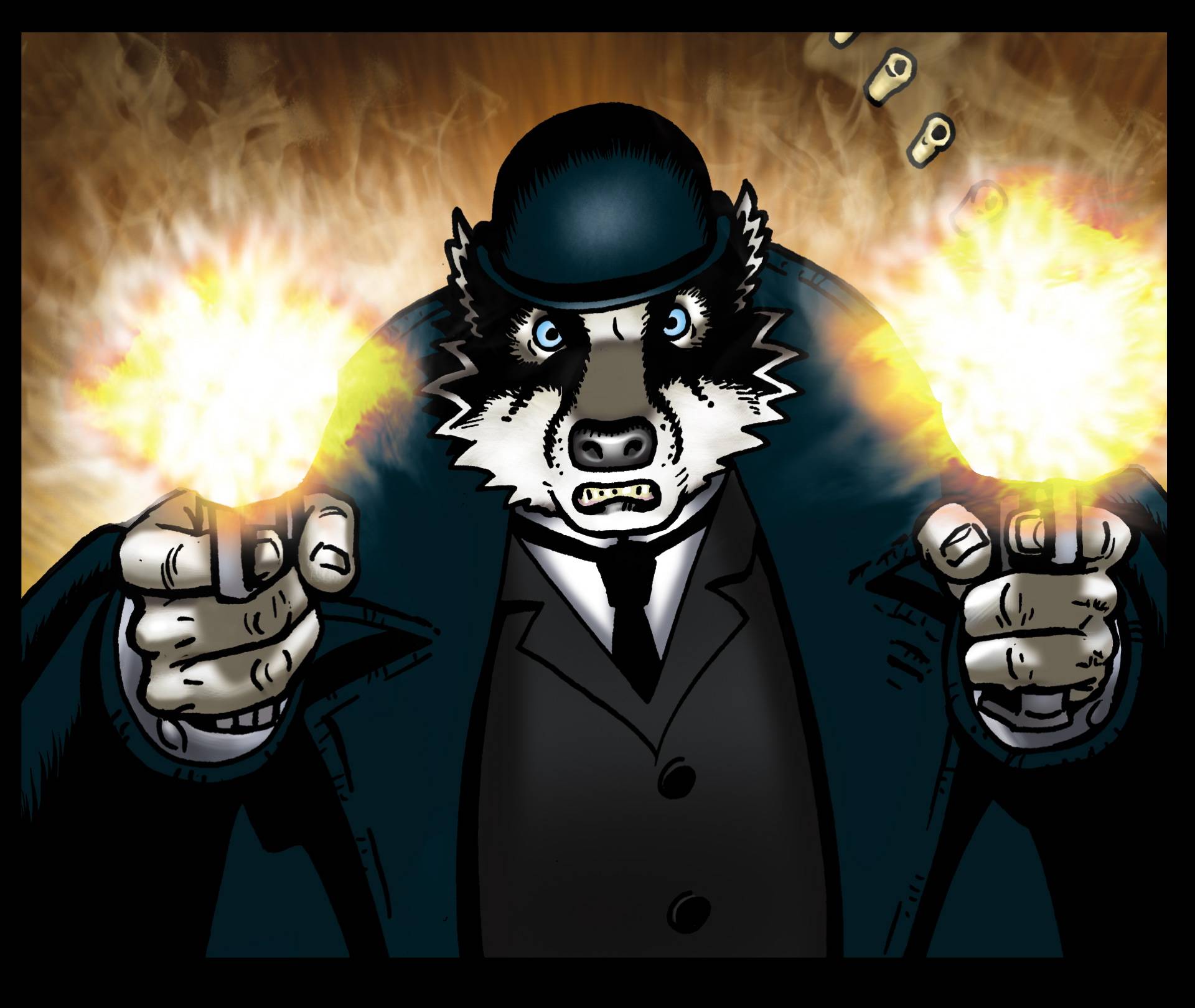Every lunchtime Bryan Talbot takes a brisk four-mile, 50 minute walk through Sunderland, taking in four parks and Keel Square, where the city’s maritime history is honoured.
In the square is the Keel Line, a strip of granite laid into pavement that tells the story of the city’s often stormy relationship with the sea, featuring illustrations by Talbot literally etched into the stone. As well as a timeline of the city’s story, it’s also a major landmark in the career of one of the most respected British comic creators of the past half a century.
The comic book industry is, arguably, enjoying something of a golden age. On the one hand, the characters from the Big Two superhero publishers Marvel and DC have never had as much exposure, thanks to the blockbuster movies that have made household names of venerable heroes previously known only to the cognoscenti – Black Panther, Ant-Man, Aquaman, Black Widow.
But although the superheroes are what many people think of when they consider comics – and indeed Talbot has worked on the American monthlies – it’s the more literary graphic novels sector that is especially burgeoning.
“I get more invitations to literary festivals than I do to comic conventions these days.”
“The graphic novel market is really healthy at the moment,” says Talbot, who turns 66 this month. Graphic novels are usually non-superhero, sometimes not fantastical at all, and are longer, more involved reads than the 20-page monthly Marvel or DC episodes. “There’s such a range of books available and the quality is amazing.
“A few years ago, there were only really a handful of quality graphic novels about; you could read the entire body of work available in a few months and there’d be nothing else. Now there’s a huge canon of quality work and it’s difficult to keep up with it all.”
There’s also increased availability of graphic novels. At one time, they were only available through specialist comic shops. Now Waterstones and even WH Smith often has a dedicated section, and they’re easily obtainable from the likes of Amazon. With their growing ubiquity has come a fresh respectability. The idea that comics are just disposable printed ephemera for kids has long been consigned to the dust.
“To be honest,” says Talbot, “I get more invitations to literary festivals than I do to actual comic conventions these days.”
Which is as it should be; Talbot is one of our most important practitioners of the art, a devout northerner who has been plying his trade for 40 years. “I never looked back after making my first comic in the 1970s,” he laughs. “I’ve never had a proper job since then!”
In the 1970s you would have found Talbot an industrious young man working his way through a career in illustration and graphic design.
Born in Newtown, Wigan, he attended Wigan Grammar School, then went on to study art at Harris College in Preston, eventually settling in the neighbouring town and taking a job first with Lancashire County Council and then with British Aerospace at Warton.
There he designed brochures not just for the aircraft the manufacturer sold worldwide, but also the attendant bases that were sold along with them. Talbot recalls: “I’d be putting together these illustrations of pots and pans, billiard tables – everything that would go into these bases that would be set up in the deserts of Saudi Arabia or somewhere.”
It was a job, and one that allowed him and his wife Mary – they married in 1972, when he was 20 and she was 18 – to buy their first home. But amid the local authority newsletters and aerospace brochures, Talbot harboured a secret – he longed to create comics.
A lifelong fan of comic books in all their forms, Talbot was particularly interested in the underground comix (spelled with an “x” to differentiate them from the mainstream superhero fare of Marvel and DC) of the time, which tackled more adult material, often breaking taboos and publishing confrontational content that sometimes landed publishers in court.

Talbot remembers: “I’d been working on my own comic about this character I came up with, Chester P Hackenbush, the Psychedelic Alchemist. Mary and I went to London to visit her brother and we ended up in this head shop on Portobello Road. There was this chap there, Lee Harris – never met him before but he was really interested in what I’d done. He was a big underground comix fan, and said that if I ever finished a whole comic he’d publish it.
“I went back up north, worked on my comic, and then hitchhiked back down to London to find him. When I presented my work to him he looked a bit blank and said he couldn’t remember us having the conversation at all. Turned out, he had no idea at all how to publish comics anyway.”
Which, you might think, is a salutary warning not to enter into publishing deals with strangers in head shops. But Harris, impressed by Talbot’s work anew, was good to his word, even if he couldn’t remember making it. The pair put together six issues of Brainstorm Comix, from late 1975 onwards, and now it’s regarded as one of the landmark underground publications in Britain.
Emboldened by the positive reception, Talbot began work on what is considered today to be one of the most ground-breaking British comics of the last four decades: The Adventures of Luther Arkwright. First published in serial form in the indie magazine Near Myths, the protagonist with the very Lancastrian name was a sort of dimension-hopping James Bond, a hip agent who worked in different parallel versions of Earth against the mysterious and chaotic Disruptors.
From there, Talbot’s star began to rise, and in 1981 when he started work on the long-running series Nemesis the Warlock for renowned British sci-fi comics weekly 2000AD, he realised he couldn’t keep up the day job as well (by now he was teaching graphic design at Preston’s Tuson College) so became a full-time comics creator.
By the 1990s he was working for DC on titles such as Batman, Hellblazer and Sandman, and renewed interest in his Luther Arkwright character saw the stories re-released and followed up by a sequel, Heart of Empire, in 1999.
The turn of the millennium brought big changes. Mary, who had had a successful academic career, took a job in Sunderland and the couple relocated there. Talbot himself began to work less for big companies and more on his own work, retaining the rights. Drawing on his new home he released Alice in Sunderland in 2007, a critically-acclaimed graphic novel telling the story of Lewis Carroll and Alice Liddell – the inspiration for the heroine of the beloved books – and their connections to the Wearside area.
In 2009 he released the first volume of Grandville, a “scientific-romance” thriller that was part-steampunk alternate reality, part Victorian adventure – and part funny-animal book, with every character portrayed as an anthropomorphic beast, fish or bird.
Publisher Jonathan Cape has just put out the fifth – and final – Grandville volume, Force Majeure, which brings to a close the ongoing story of Detective Inspector LeBrock of Scotland Yard (a badger, need you ask?) and the sumptuous alternate reality that has earned Talbot huge praise over the past nine years. But why animals?
“I suppose that came out of the Alice in Sunderland book. Tenniel, who did the illustrations for the original Alice books, did animals that adopted human characteristics, and he was heavily influenced by a 19th century artist called Jean Ignace Isidore Gérard. When I was researching the Alice book I remembered I had a book on Gérard which I’d got from some second-hand shop in the 1970s, and had always been fascinated by his satirical drawings.
“Gérard signed his work JJ Grandville, and it struck me that this would be a great nickname for a city such as Paris in the 19th century, and then I thought, well, why not do all the characters as animals? It wasn’t something I’d done before, and I like to set myself new challenges.
“Besides, the idea of anthropomorphic animals isn’t anything new. There are Neolithic cave paintings with humans with animal heads, the ancient Egyptians gave their gods animal aspects.”
Grandville has proved hugely popular, and at the end of last year was optioned by Euston Films, part of FremantleMedia, to be turned into a TV series which would mix live action with CGI for the animal effects. “That was really nice,” says Talbot.
Just nice?
“It will be brilliant if it happens, I hope it does,” he adds, with what you suspect is a smidgen of true northern refusal to get too excited until he sees it actually on the screen. But with respected Doctor Who and New Tricks screenwriter Julian Simpson on board for the adaptation, it would seem to be in safe hands.
Mary, once she retired from academia, entered the world of graphic novels as well. In 2012 she wrote the script for Dotter of Her Father’s Eyes, a mix of memoir of growing up in Wigan and biography of Lucia Joyce, daughter of James. Illustrated by her husband, it was published by Jonathan Cape and went on that year to become the first – and so far only – graphic novel to win the Costa Biography Prize.
“Mary’s certainly won a bigger award than I’ve ever got, but I’m not bitter,” laughs Talbot.
They’ve collaborated on two more books since then – Sally Heathcote: Suffragette and 2016’s The Red Virgin and the Vision of Utopia, about the life of revolutionary feminist Louise Michel. Talbot is used to both writing and illustrating his own work these days; is there any friction working so closely with his spouse?
“We don’t have domestics about it. We’ve been married 40-odd years so we know how to get on!”
The challenge of the Grandville series has been an exhausting one – there are 164 pages in Force Majeure, and each page of art takes Talbot about four days to complete, not counting writing and plotting the novel first. But he’s not planning to retire any time soon and is in as much demand as ever, flying out to comic conventions and literary festivals across the world. He works seven days a week, often until 9pm, breaking off for his walk past the Keel Line, where his illustrations form perhaps the longest comic book in the world.
He’s several dozen pages into drawing the next book written by Mary, which will have an environmental slant, against the backdrop of the devastating floods that hit the north in 2015, especially Hebden Bridge, where the book will be set.
After that it will be back to a Bryan Talbot project but he’s not yet sure what it will be. “I do have an idea for a 230-page fantasy graphic novel that I’ve had for a while and keep looking at again. And I’ve also got a massive file with notes for a new Luther Arkwright project. But I just need to find exactly the right hook for it.”
Like the Big Issue North on Facebook




Leave a reply
Your email address will not be published.